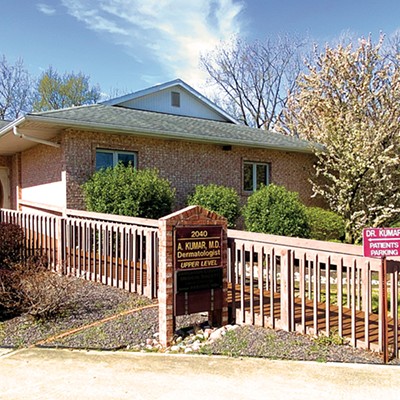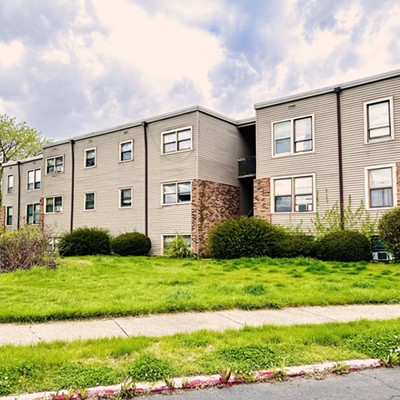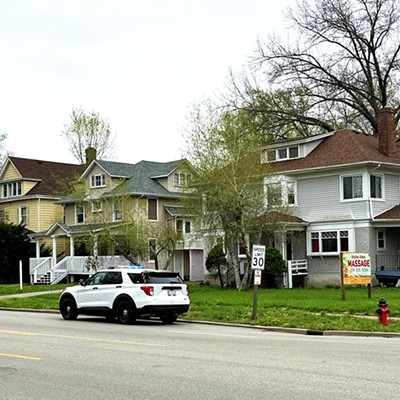The State Journal-Register today offers a useful retrospective on the evolution of the Lincoln Home National Historic Site by Tara McClellan McAndrew. ("Protecting Lincoln's legacy in his neighborhood has evolved with the times.")
More might be said on that subject – indeed more has been said. In “A new old street” which appeared in this paper on Jan. 19, 2010, I put in my two cents’ worth:
The [National Park Service] has dubbed its preferred management approach “A Retreat From Modern Life in the Heart of the City,” but the finished historic core won’t retreat very far. Flush toilets and water will be available next door to the Lincolns’ house, which visitors approach on streets of gravel rather than the original dirt. There are no clothes hanging on wash lines, no peeling paint on the fences, no unmowed grass in the yards as there would have been in Lincoln’s day. Period photographs show weeds growing in the sidewalks in front of the house, and a sagging back fence; a detail from one photo is captioned by the NPS, “Mr. Lincoln was not known as ‘Mr. Fixit.’” You wouldn’t know it by touring the grounds today.
In short, the site will continue to be maintained according to a rigorous period standard, except when it isn’t. The new houses and other structures may meet museum-level curatorial standards as replicas, but they are likely to remain unconvincing as history because of the agency’s fussy suburban aesthetic.
That was my last word on the home
site – for the moment – but it was hardly the only one. In “Faithful
to the period” from Sept. 2, 2010,
I suggested that for visitors to experience the street as the Lincolns did,
they would need to see peeling paint on the barns, unmowed grass and horse crap
on the ground, the reek of coal smoke and outhouses in the air.
Even that was a reprise in part of a complaint I had made twenty years earlier, in “Ghost Houses” (Nov. 20, 1990), a column in my old Prejudices series. As I suggested then, “better if Eighth Street were dug up and left as dirt; NPS guides would have to nag visitors to scrape their boots before they come inside, as Lincoln and the kids no doubt were reminded by his wife.”
But don’t take my word for my words. Here’s the whole thing.
I talked to a nice man in Denver the other day, a Mr. B., who for several years in the 1970s headed the National Park Service design team that planned the Lincoln Home National Historic Site. I had hinted rudely that some criticism of the feds' work in Springfield might be fairly made, and he volunteered the judgment that the Lincoln home project was one of the successes of his tenure.
Doubtless it was. In the shuttered world of the federal bureaucracy any project is a success that doesn't fail as miserably as such projects usually do. I am obliged to say, however, that after nearly 20 years the place has not grown on me. Familiarity inured me to all sorts of foolishness in Springfield -- I ate horseshoe sandwiches and even voted once or twice -- but the failures of the Lincoln home site to either inspire or teach continue to nag. Out of politeness to Mr. B. I will phrase this in as kindly a way as I can: The LHNHS is a monument to muddle.
The National Park Service had three options in developing those four blocks along Eighth Street when it took them over in 1971. One was to restore the house while leaving the existing neighborhood physically intact. Another was to restore the house and build a park around it -- set the house on a doily in effect. The last and most ambitious option was to make the restored house the centerpiece of a larger restoration that might give visitors some taste of the times and place as well as of the house itself.
Ever innovative, the Park Service chose to do none of the three. Or rather it attempted all three at once. Ostensibly restored to its 1850s appearance, the old neighborhood still boasts numerous nonperiod features, from landscape plantings to architecture. (There is a 1890s porch on the house across the street from the Lincoln house, for example.) And although the ambiance on Eighth Street is park-like, it is not a park; the meticulously maintained lots are off limits to picnicking or play, even lounging.
Detail after detail betrays confusion at the heart of the Park Service's concept for the site. Springfield in the 1850s was not New York, but neither was it Yellowstone, as the pines that screen the parking lot suggest. The visitors center was built of brick (virtually all the houses on the site were wood frame) and boasts a ridged metal roof that, it was explained, recalled the sheds and barns of the original neighborhood. The result is a building so inconspicuous that first-time visitors routinely overlook it. And for all its concern for context, the center's low-slung and angular profile managed to disappoint the many locals who found it much too modern.
Most disappointing is the Park Service's continuing failure to achieve the promised recreation of the 1850s Eighth Street as an interpretive setting for the house. The old boarding house ambience of Eighth Street may have been historically incorrect but it would have been more familiar to Lincoln than the Park Service's version. It resembles a residential block as much as White Oaks' center court resembles a city square; the empty lots have been tidied up with cute white board fences that make the street look like an HO train set. (This is one of those rare cases in which vandals who tear out the pickets actually improve a public property.)
The NPS strove expensively for authenticity in its restoration of the Lincolns' house, yet authenticity is mocked elsewhere in the site's core area. Nonperiod houses were banished, for example, but nonperiod trees were not. (It is extremely unlikely that the street Lincoln knew had trees that were so numerous or so large.) The NPS would never dare install a TV set in the parlor of the house, yet the street outside is so cluttered with motorized carts and leaf blowers and snow plows that it is not Springfield's 1850s downtown it invokes but one of its 1990 subdivisions.
For visitors to experience the street as the Lincolns did, they would need to see clothes hanging on wash lines. Vacant lots would not have looked like suburban lawns but weedy outposts that no doubt were appropriated by neighborhood kids as playgrounds (and possibly by their parents as dumping grounds). Fences weren't always painted, and the grass wasn't always mowed.
The Park Service has made some attempts to alleviate the stage-set atmosphere of the core area. Leasing restored period houses for residential and office use is one example. So are the wood plank walkways that crisscross the site. But the lesson of those walkways is lost in an environment that is immaculately paved and turfed. They would make their point more convincingly if Eighth Street were dug up and left as dirt; the pedant in me finds rather appealing the vision of NPS guides yelling at visitors to remember to scrape their boots before they come inside, as Lincoln and the kids no doubt were reminded by his wife. And what experience would make a visit to Springfield linger more vividly in the mind of tourists than having to use an outdoor privy just like the Lincolns?
There is much that a responsible agency would not want to recreate about 1850s Springfield, such as the sting of coal smoke in the air or the stink of hogs in the streets. Less happily, there is probably no chance that the houses now missing from Eighth Street will ever be reconstructed, even if detailed records were available. (Only a few of the missing 1850s houses appear in photos taken in the 1880s, although the outlines of all of them appear in insurance company maps from the 1850s.)
Strict authenticity being apparently impossible, why not opt for history of a more imaginative type? Why not borrow a page from an award-winning design done by the architectural firm Venturi, Rauch & Scott Brown at Philadelphia's Franklin Court, part of the Park Service's Independence National Historical Park? Ben Franklin's long vanished house was not rebuilt. Instead, its presence on the site is suggested by a timber frame of the structure that outlines the walls and roof line, even the chimneys of the original. It is a sketch in wood whose insubstantiality is a tease. It conveys a sense of bulk without having any, and in doing so variously evokes a child's drawing of a house or a computer image. What addition to an unreal street could be more perfect than unreal houses? What better place for a ghost to dwell than a neighborhood of ghost houses?
















